![]()
![]()
![]()
Use LEFT and RIGHT arrow keys to navigate between flashcards;
Use UP and DOWN arrow keys to flip the card;
H to show hint;
A reads text to speech;
31 Cards in this Set
- Front
- Back

What is the relationship between amplitude and loudness?
|
Amplitude: Intensity of a sound wave.
Loudness: Perception of a soundwave's intensity. |
|
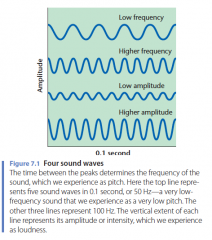
What is the relationship between frequency and pitch?
|
Frequency: Number of compressions per second, measured in herts (Hz) of a sound.
Pitch: Perception closely related to frequency (the higher the frequency of a sound, the higher its pitch). |
|
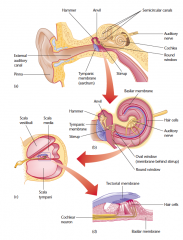
What are the roles of the tympanic membrane, the hammer, the anvil, and the stirrup?
|
Tympanic membrane (eardrum): Vibrates at the same frequency as the sound waves that strike it. It is attached to three tiny bones: malleus, incus, and stapes.
Malleus (hammer), Incus (anvil), and Stapes (stirrup): Sends vibrations into the oval window of the inner ear. |
|
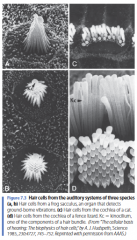
Where are the auditory receptors located and how are they stimulated?
|
- The stirrup causes the oval window to vibrate, setting in motion all the fluid in the cochlea.
- The AUDITORY RECEPTORS (hair cells) lie between the BASILAR MEMBRANE and the TECTORIAL MEMBRANE in the COCHLEA. - When fluid in the cochlea vibrates, a shearing action occurs which stimulates hair cells; these cells then stimulate the auditory nerve cells (the eighth cranial nerve). |
|
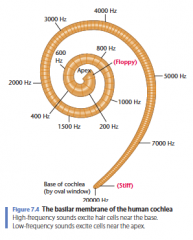
What is the range of frequency most adult humans can hear?
|
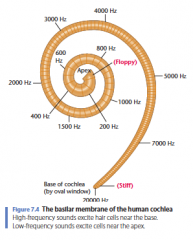
Most adult humans can hear vibrations from 15 or 20 Hz to just less than 20,000 Hz.
|
|
|
What structures make up the "outer ear?"
|
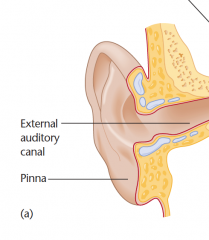
The structures of the outer ear:
- The pinna (the structure of flesh and cartilage attached to the side of the ear). - The auditory canal. |
|
|
What structures make up the "middle ear?"
|
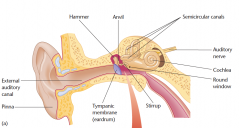
The structures of the middle ear:
- The tympanic membrane (eardrum). - The malleus (hammer). - The incus (anvil). - The stapes (stirrup). |
|
|
What structures make up the "inner ear?"
|
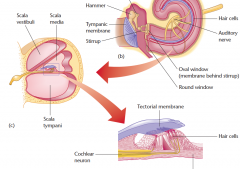
The structures of the inner ear:
- The oval window (receives vibrations from the tiny bones of the middle ear) - The cochlea (contains three fluid-filled tunnels: the scala vestibule, scala media, and scala tympani) |
|
|
What is the "frequency theory" of pitch perception?
|
Frequency Theory: We perceive certain pitches when the basilar membrane vibrates in synchrony with a sound >>> causing the axons of the auditory nerve to produce action potentials at the same frequency.
|
|
|
What is the "volley principle of pitch discrimination?"
|
The Volley Principle of pitch discrimination: Sound waves produce a volley of impulses by auditory nerve fibers, which in turn signal high frequencies to the brain.
|
|
|
What is the "place theory" of pitch perception?
|
Place Theory: Each area along the basilar membrane is tuned to a specific frequency and vibrates whenever that frequency is present. Each frequency activates hair cells at only one place along the basilar membrane and the brain distinguishes frequencies by what neurons are activated.
|
|
|
What is the "tonotopic map?"
|
The Tonotopic Map: The map of sounds the auditory cortex makes.
|
|
|
What is "conductive deafness?"
|
Conductive Deafness (middle ear deafness): Failure of the bones of the middle ear to transmit sound waves properl to the cochlea. Can be corrected by surgery or hearing aids.
|
|
|
What is "tinnitus?"
|
Tinnitus: Frequent or constant ringing in the ear. Common in people with nerve deafness and is due in some cases to a phenomenon like "phantom limb."
|
|
|
Timing differences can be used most accurately for localizing what type of sounds?
|
Sudden-onset sounds.
|
|
|
What is "nerve deafness?"
|
Nerve Deafness (inner ear deafness): Damage to the cochlea, hair cells or auditory nerve causing a permanent impairment in hearing in one to all ranges of frequencies. Can be inherited, due to prenatal problems, or early childhood disorders.
|
|
|
What is the "primary auditory cortex?"
|
The primary auditory cortex: The Temporal Lobe.
|
|
|
Damage to the primary auditory cortex leads to what, as opposed to a loss of hearing?
|
Damage to the primary auditory cortex leads to:
- Deficits in processing auditory information - An inability ro recognize combination or sequences of sounds (music or speech). |
|
|
How does each hemisphere of the brain receive its major auditrory input?
|
Auditory information crosses over between the "superior olive" and the "inferior colliculus" so that each hemisphere receives its major auditory input from the opposite ear.
|
|
|
What is the "somatosensory system?"
|
The Somatosensory System: The system that processes sensations of the body and its movements.
Includes: - discriminative touch - deep pressure - coldness - warmth - pain - itch - tickle - the position of joints - the movement of joints |
|
|
What is "vestibular sensation?"
|
Vestibular Sensation: Specialized to detect the position and movement of the head.
|
|
|
What are the "mechanical senses?"
|
The Mechanical Senses:
- Touch - Pain - Vestibular sensation |
|
|
What is "substance P?"
|
Substance P: A neuromodulator or cotransmitter with glutamate used by unmyelinated or thinly myelinated axons to relay pain information to the spinal cord.
|
|
|
What is "capsaicin?"
|
Capsaicin: A chemical that causes neurons that contain 'Substance P' to release it suddenly. This chemical eventually leads to insensitivity to pain because neurons release 'Substance P' faster than they can resynthesize it.
|
|
|
What is the "gate theory?"
|
Gate Theory: Information not related to pain travels to the spinal cord and closes the "gates" for each pain message.
|
|
|
Where in the brain are 'endorphins' released in response to certain painful stimuli?
|
Certain painful stimuli activate neurons that release endorphins in the periaqueductal gray area in the midbrain.
|
|
|
How do endorphins block pain?
|
Endorphins block pain by blocking the release of 'substance P' in the spinal cord and brainstem.
|
|
|
What kind of pain do endorphins (and other opioids) block?
|
Endorphins and other opioids block DULL pain, but NOT SHARP pain.
|
|
|
What produces the sensation of itch?
|
The sensation of itch is produced by the release of histamines.
|
|
|
What is the difference between "taste" and "flavor?"
|
Taste: Caused by the stimulation of taste buds.
Flavor: Caused by a combination of stimulations from the taste buds and olfactory receptors. |
|
|
What is "olfaction?"
|
Olfaction: The sense of smell.
|

